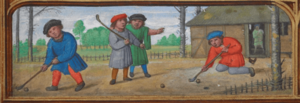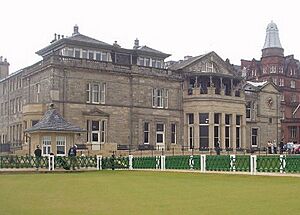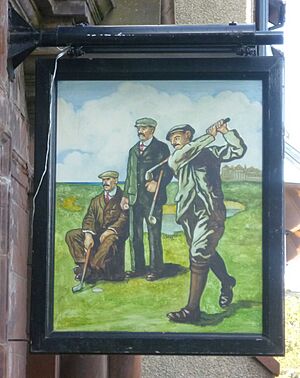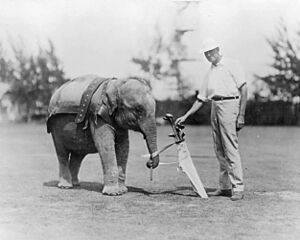History of golf facts for kids
The game of golf has a long and interesting history, though its exact beginnings are a bit unclear and often debated. Most people agree that the modern game of golf, as we know it today, started in Scotland during the Middle Ages. It didn't become popular around the world until the late 1800s. That's when it spread across the United Kingdom, then to the British Empire, and finally to the United States.
Contents
Where Did Golf Begin?
Early Games in the Netherlands
Some stories say that a game similar to golf was played in the Netherlands on February 26, 1297. In this game, Dutch players used a stick and a leather ball. The goal was to hit the ball into a target hundreds of yards away using the fewest swings. Some experts believe this game, where a small ball was hit into a hole with "golf clubs," was played in the Netherlands in the 1600s, even before it was played in Scotland.
There are also other old reports of games like golf from different parts of Europe.
In 1261, a Flemish poet named Jacob van Maerlant wrote about a ball game played "mit ener coluen" (with a colf/kolf [club]). This is the first time the game of colf/kolf is mentioned in Dutch, as played in the Low Countries.
In 1360, the city council of Brussels banned the game of colf. They said anyone playing it would have to pay a fine or lose their overcoat!
Later, in 1387, a ruler named Albrecht of Bavaria allowed the city of Brielle to play "the ball with a club outside the town walls." This was an exception to a rule against playing games for money. Two years later, in 1389, Albrecht gave the people of Haarlem a special field called "De Baen" (the course). It was just for playing games, especially colf, because playing inside the city was too dangerous.
A game that looks like modern golf is shown in a special book from 1540. This book is now called the Golf Book because of this picture. A Flemish artist named Simon Bening drew the pictures in it.
In 1571, a book called "Biblia dat is, de gantsche Heylighe Schrift, grondelic ende trouwclick verduydtschet" described the game of "Kolf" played with a "bat" and "sach."
In 1597, the crew of Willem Barentsz played "colf" while they were staying in Nova Zembla. This was written in a diary by Gerrit de Veer:
The 3rd of April the weather was nice and clear with a north-easterly wind and quiet, then we made a colf [club] to play colf with, and thus make our limbs more loose, for which we sought every means.
In December 1650, people living in Fort Orange (which is now Albany, New York) played the first recorded game of kolf (golf) in America. These Dutch settlers played kolf all year round. In spring, summer, and fall, they played in fields. In winter, they played on ice using the same rules. Later, on December 10, 1659, the local government made a rule against playing golf in the city streets because too many windows were getting broken.
Early Golf in Scotland
Most people believe that the modern game of golf was invented in Scotland. A spokesperson for The Royal and Ancient Golf Club of St Andrews, one of Scotland's oldest golf groups, said that while stick and ball games have been around for centuries, golf as we know it today, played over 18 holes, definitely started in Scotland. The word golf, or gowf in Scots, is thought to come from the Dutch word "colf" or "colve" which means "stick" or "club".
The first official mention of golf in Scotland was in 1457. The Scottish Parliament, led by King James II of Scotland, made a law banning games like gowf and futball. This was because these games were distracting people from practicing archery, which was important for the military. The ban was put in place again in 1471 and 1491, with golf being called "an unprofitable sport." Even King James IV of Scotland banned golf, but he later bought golf clubs and balls for himself in 1502 when he visited Perth, and also when he was in St Andrews and Edinburgh.
Mary, Queen of Scots also played golf. She was criticized for playing "pell-mell and golf" at Seton Palace in 1567, shortly after her husband Lord Darnley died. People thought she should have been in mourning. George Buchanan wrote that she was enjoying her "usual amusements in the adjoining fields that were plainly not adapted to women."
In Edinburgh, the Town Council records from April 19, 1592, list golf as a game to avoid on Sundays. On February 13, 1593, the Duke of Lennox and Sir James Sandilands planned to go to Leith to play golf. On their way, they met members of the Graham family, who were fighting with Sandilands, and instead of playing golf, they fought with pistols.
A lawyer named Sir John Foulis of Ravelston wrote in his diary that he played golf at Musselburgh Links on March 2, 1672. This is seen as proof that The Old Links, Musselburgh, is the oldest golf course in the world that is still used. There's also a story that Mary, Queen of Scots played there in 1567.
James VII of Scotland, who was then the Duke of Albany, is said to have played in the first international golf match in 1681. He played against two English noblemen as part of a bet to decide if golf belonged to Scotland or England. His teammate was a man named John Paterson, who was paid enough money to build a large house in an area of Edinburgh now called Golfers Land.
Golf Rules and Early Competitions
The earliest known instructions for playing golf were found in the diary of Thomas Kincaid. He was a medical student who played golf at Bruntsfield Links, near Edinburgh University, and at Leith Links. His notes even included his ideas for an early handicap system. On January 20, 1687, he wrote about going "out to the Golve" after dinner. He described his golf stroke:
I found that the only way of playing at the Golve is to stand as you do at fenceing with the small sword bending your legs a little and holding the muscles of your legs and back and armes exceeding bent or fixt or stiffe and not at all slackning them in the time you are bringing down the stroak (which you readily doe)
The oldest golf rules that still exist were written in 1744 for the Company of Gentlemen Golfers. This group later changed its name to The Honourable Company of Edinburgh Golfers and played at Leith Links. Their "Articles and Laws in Playing at Golf" are now kept in the National Library of Scotland. They are known as the Leith Rules. This document helps the club claim to be the oldest golf club. The rules in the Leith Rules became the basis for all golf rules that followed. For example, they said that "Your Tee must be upon the ground" and "You are not to change the Ball which you strike off the Tee."
In 1744, the Gentlemen Golfers competed for the Silver Club. This was a silver golf club trophy given by the Edinburgh Town Council. The winner was a surgeon named John Rattray. He had to put a silver ball with his name on it onto the trophy, starting a long tradition. Rattray joined the Jacobite Rising of 1745 and was put in prison. But he was saved from a serious punishment by his fellow golfer Duncan Forbes of Culloden. Rattray was set free in 1747 and won the Silver Club three times in total.
How Golf Spread Around the World
Early Journeys of Golf
In 1603, James VI of Scotland became King of England. His son, the Prince of Wales, and his friends played golf at Blackheath, London. The Royal Blackheath Golf Club traces its beginnings to this time. There is proof that Scottish soldiers, people living abroad, and immigrants took the game to British colonies and other places in the 1700s and early 1800s. In the early 1770s, the first golf course in Africa was built on Bunce Island in Sierra Leone by British traders.
The Royal Calcutta Golf Club (1829) in India, the Mauritius Gymkhana Club (1844), and the club at Pau (1856) in southwestern France are important examples of these early golf trips. They are the oldest golf clubs outside of the British Isles. The Pau Golf Club is the oldest in continental Europe. However, golf didn't become widely popular outside Scotland until the late 1800s.
The Golf Boom of the Late 1800s
In the 1850s, Queen Victoria and Prince Albert built Balmoral Castle in the Scottish Highlands. The railways reached St Andrews in 1852. By the 1860s, there were fast and regular train services from London to Edinburgh. The royal family's love for Scotland, much better transport, and the writings of Sir Walter Scott led to a big increase in tourism in Scotland. This also sparked more interest in Scottish history and culture outside the country.
This time also saw the invention of the Gutty. This was a golf ball made of Gutta Percha. It was cheaper to make in large amounts, lasted longer, and performed better than the old leather balls filled with feathers. Golf then started to spread across the rest of the British Isles. In 1864, the Royal North Devon Golf Club became the first new club in England since Blackheath. The next year, the London Scottish Golf Club was started on Wimbledon Common. In 1880, England had 12 golf courses. This number grew to 50 by 1887 and over 1000 by 1914. By 1890, golf in England was popular enough to have its first English-born Open Champion, John Ball. The game also spread further across the British Empire. By the 1880s, golf clubs were set up in Ireland, Australia, New Zealand, Canada, and South Africa. Singapore followed in 1891. Courses were also built in several European resorts for British visitors.
Golf in the United States
In December 1650, near Fort Orange (modern Albany, New York), four men played Kolf in teams. On July 22, 1657, some men were told not to play Kolf on Sundays. On December 10, 1659, a rule was made to stop playing Kolf in the streets of Albany because too many windows were being broken.
Early signs of golf in what is now the United States include a record from 1739. It shows a shipment of golf equipment to a William Wallace in Charleston, South Carolina. Also, an advertisement was published in the Royal Gazette of New York City in 1779 for golf clubs and balls. The South Carolina Golf Club was started in 1787 in Charleston. However, just like in England, golf didn't really take off until the late 1800s.
Several clubs started in the 1880s can claim to be the oldest still existing in the country. What is certain is that in 1894, because there were two different "National Amateur Championships" being played, representatives from several clubs met in New York City. These clubs included the Newport Country Club, Bob Bobbin's Golf Club, Yonkers, New York, The Country Club, Chicago Golf Club, and Shinnecock Hills Golf Club. This meeting led to the creation of the United States Golf Association (USGA). By 1910, there were 267 golf clubs in the US.
During the Roaring Twenties, golf became much more popular. By 1932, over 1,100 golf clubs were part of the USGA. In 1922, Walter Hagen became the first American-born player to win the British Open Championship. The growth of the game slowed down during the Great Depression and World War II, but it picked up again after the war. By 1980, there were over 5,908 USGA-affiliated clubs. This number grew to over 10,600 by 2013. Starting in the 1920s, and growing through the 1990s, many neighborhoods were built around golf courses.
Golf in Japan
After the Meiji restoration of 1868, Japan worked hard to modernize its economy and industries like Western countries. Japanese people went to Europe and America to create trade links and learn about the newest developments in business, science, and technology. Westerners also came to Japan to help set up schools, factories, shipyards, and banks.
In 1903, a group of British people living in Japan started the first golf club there, at Kobe. In 1913, the Tokyo Golf club at Komazawa was started for Japanese people who had learned about golf in the United States. This club later moved to Asaka in 1932. In 1921, Japan built the first golf course in Korea at Hyochang Park, which had tombs of Korean royalty. The game was played around these tombs. In 1924, the Japan Golf Association was formed by the seven golf clubs that existed then.
During the 1920s and early 1930s, several new courses were built. However, the Great Depression and growing anti-Western feelings limited how much the game grew. By the time of the Japanese attacks against the USA and British Empire in 1941, there were 23 courses. During the war that followed, most of the courses were taken over for military use or turned back into farmland.
After the war, Japan's golf courses were controlled by the occupying forces. It wasn't until 1952 that courses started to be given back to Japanese control. By 1956, there were 72 courses. In 1957, Torakichi Nakamura and Koichi Ono won the Canada Cup (now World Cup) in Japan. This event is often said to have started the big golf boom after the war. Between 1960 and 1964, the number of golf courses in Japan jumped from 195 to 424. By the early 1970s, there were over 1,000 courses. A law in 1987, called the Resort Law, made it easier to build on farmland and forest areas. This led to another huge boom in course building. By 2009, there were over 2,400 courses. Golf's popularity in Japan also led to many golf resorts being built across the Pacific Rim. Many people are concerned about the environmental effects of these recent golf booms.
Golf in Tibet
Hugh Edward Richardson brought golf to Tibet. He noticed that the ball "tended to travel 'rather too far in the thin air'" because of the high altitude.
How Golf Courses Changed
Golf courses haven't always had eighteen holes. The St Andrews Links in Scotland is a narrow strip of land along the sea. As early as the 1400s, golfers at St Andrews created a path through the bumpy land. They played to holes whose locations were decided by the natural shape of the ground. The course that developed had eleven holes, laid out one after another from the clubhouse to the far end of the property. Players would play all the holes out, then turn around and play them back in, for a total of 22 holes. In 1764, some of the holes were thought to be too short, so they were combined. This reduced the number of holes from 11 to 9. So, a full round of the links became 18 holes. Because St Andrews was so important in golf, all other courses started to follow this example, and 18 holes is still the standard today.
How Golf Equipment Developed
The way golf is played has changed a lot because of how the equipment has improved. Some of the biggest changes in golf have come from the development of the golf ball. The golf ball looked very different before the 1930s. That's when the United States Golf Association (USGA) set rules for its weight and size. These rules were later followed by a USGA regulation saying that a golf ball's starting speed could not be more than 250 feet per second. Since then, the golf ball has continued to get better and has changed how the game is played.
Another important factor in golf's evolution has been the development of golf clubs. The first golf clubs were made from wood that was easy to find nearby. Over the years, hickory became the standard wood for the club shafts. American persimmon wood was chosen for the club head because it was hard and strong. As the golf ball improved and became tougher with the "gutty" ball around 1850, club heads could also develop. This led to different types of iron-headed clubs being used in the game.
Steel shafts for clubs started to appear in the late 1890s, but it took a while for golf's governing bodies to accept them. In the early 1970s, shaft technology changed again with the use of graphite, which is light and strong. The first metal "wood" club was developed in the early 1980s. Metal eventually completely replaced wood because it was stronger and more versatile. The newest golf club technology uses graphite shafts and light titanium heads. This allows the club head to be made much larger than before. The strength of these modern materials also means the club face can be much thinner. This increases how much the club face springs when it hits the ball, which theoretically makes the ball travel farther. In 2003, the USGA and R&A started to limit this spring-like effect, also known as the coefficient of restitution (COR), to 0.83. They also limited the maximum club head size to 460 cubic centimeters. This was done to keep the game challenging.
What Does "Golf" Mean?
The word golf was first written down in 1457 in a Scottish law about forbidden games. It was spelled gouf. This might come from the Scots word goulf (spelled in different ways), meaning "to strike or cuff." This word, in turn, might come from the Dutch word kolf, meaning "bat" or "club," and the Dutch sport with the same name.
The Dutch term Kolf and the Flemish term Kolven refer to a similar sport. In this game, the winner is the person who hits a ball into a hole with a mallet using the fewest swings. A French-Flemish dictionary printed in 1643 states the Dutch term for Flemish: "Kolf, zest Kolve; Kolfdrager, Sergeant; Kolf, Kolp, Goulfe."
There's a common urban legend that says the word golf comes from an acronym "Gentlemen Only, Ladies Forbidden." This is a false etymology, meaning it's not true. Acronyms being used as words is a fairly new thing, so this saying is actually a backronym (a made-up meaning for a word).
J. R. R. Tolkien, who was an expert in languages, hinted at the word's origin from the Dutch word for club in his 1937 fantasy novel The Hobbit. In the book, he jokingly mentions that the game of golf was invented when a hobbit with a club knocked the head off a goblin named Golfimbul. The head then flew through the air and landed in a rabbit hole.
Golf Museums
The history of golf is kept alive and shown at several golf museums around the world. These include the R&A World Golf Museum in St Andrews, Fife, Scotland. This is the home of The Royal and Ancient Golf Club of St Andrews. Another is the United States Golf Association Museum, located next to the United States Golf Association headquarters in Far Hills, New Jersey.
The World Golf Hall of Fame in St. Augustine, Florida, also tells the story of the sport. So does the Canadian Golf Hall of Fame in Oakville, Ontario, and the American Golf Hall of Fame in Foxburg, Pennsylvania, at the Foxburg Country Club.
There are also museums dedicated to individual players, like the Jack Nicklaus Museum in Columbus, Ohio. The USGA Museum also has special rooms for Bobby Jones, Arnold Palmer, and Ben Hogan.
Images for kids
-
The MacDonald boys playing golf by 18th-century portrait painter Jeremiah Davison
See also
 In Spanish: Historia del golf para niños
In Spanish: Historia del golf para niños
- Timeline of golf history (1353–1850)
- Timeline of golf history (1851–1945)
- Timeline of golf history (1945–1999)
- Timeline of golf (2000–present)
- R&A World Golf Museum








